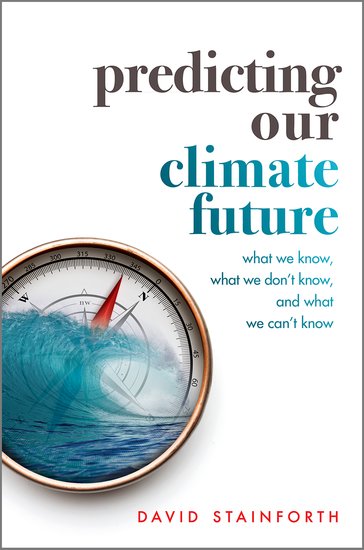Predicting Our Climate Future: What We Know, What We Don’t Know, and What We Can’t Know
- By David Stainforth
- Oxford University Press
- 368 pp.
- Reviewed by John R. Wennersten
- January 8, 2024
Are projections about global warming really just guesstimates?

“Prediction is difficult, especially about the future.”
– Niels Bohr
On June 23, 1988, James Hansen, a top NASA scientist, told Congress and the world that global warming had arrived. His observation was prescient: We now live on a far less healthy, hotter, and more dangerous planet than even Hansen anticipated in the 1980s.
Since then, there has been a tsunami of books, essays, and reports on the impact of climate change. Most notable have been the works of Hansen himself (Storms of My Grandchildren), Bill McKibben (Eaarth), Amitav Ghosh (The Great Derangement), and Elizabeth Kolbert (The Sixth Extinction), and the research of Oxford climatologist Myles Allen. Together, they provide a wealth of knowledge and perspectives on the existential dangers we face.
Now to add to the flood of climate-change literature comes David Stainforth’s readable, erudite Predicting Our Climate Future. The author wants us to understand the intricacies of climate change in terms of its being “nonlinear” — something not easily modeled by computers or replicable in a laboratory.
For the layman, this is a challenging but necessary read. (You can’t always have environmental data effortlessly plopped on your plate like mashed potatoes in a cafeteria.) Too often, says Stainforth, people seek information on climate change that bolsters whatever views they already have and look to science to support those assumptions. His book seeks to explain how scientists make climate-change predictions in the first place and the inherent trickiness of doing so. After all, how do we make judgments about what we don’t know?
At issue is the reliability of these predictions. When it comes to climate change, scientists are entering new territory where past statistical, historical, and cultural markers no longer apply. “How we go about the task, what assumptions we make and how to test whether our methods work are questions which challenge the approaches of modern science to their extremes,” writes Stainforth.
For one, scientists must struggle to predict what hasn’t yet been observed. While laboratory science is based on the study of repetitive situations, explains the author:
“Under climate change, previously impossible behavior may become possible and things that have previously been possible or even commonplace, may become impossible or very, very, very unlikely.”
Today, scientists approach the problem of climate change with newer and bigger computer models, but these models are often influenced by the different experiences and perspectives the scientists themselves have. Although researchers assert the dependability of their predictions, Stainforth notes, “we need to understand what assumptions they make and the basis on which they might claim reliability.” Measuring climate change isn’t easy, especially when so many cultural and political factors go into securing the necessary funding to do so.
Another problem, says the author, is that we’re locked into our familiar way of seeing the world and thus are unprepared for what environmental historian John McNeill calls “something new under the sun.” In other words, we know where we’ve been but not necessarily where we’re going. We want to know, but the best we can do is use computer models to give us probabilities. But how can we relate what happens on a screen to what will happen on the ground? It’s this contextual basis of the research that gives “an impression of false confidence in what climate science and climate models can provide.”
We do, however, already have lots of mostly reliable data about climate change, so if we can get away from being distracted by what Stainforth calls “the grail of the perfect,” then climate-change science will be able to offer many ways to support society. In the meantime, his book is a helpful addition to furthering our understanding about matters of probability in our age of a warming planet.
John R. Wennersten is an environmental historian. His recent books include Global Thirst and Rising Tides: Environmental Refugees in the 21st Century.

_80_122.png)